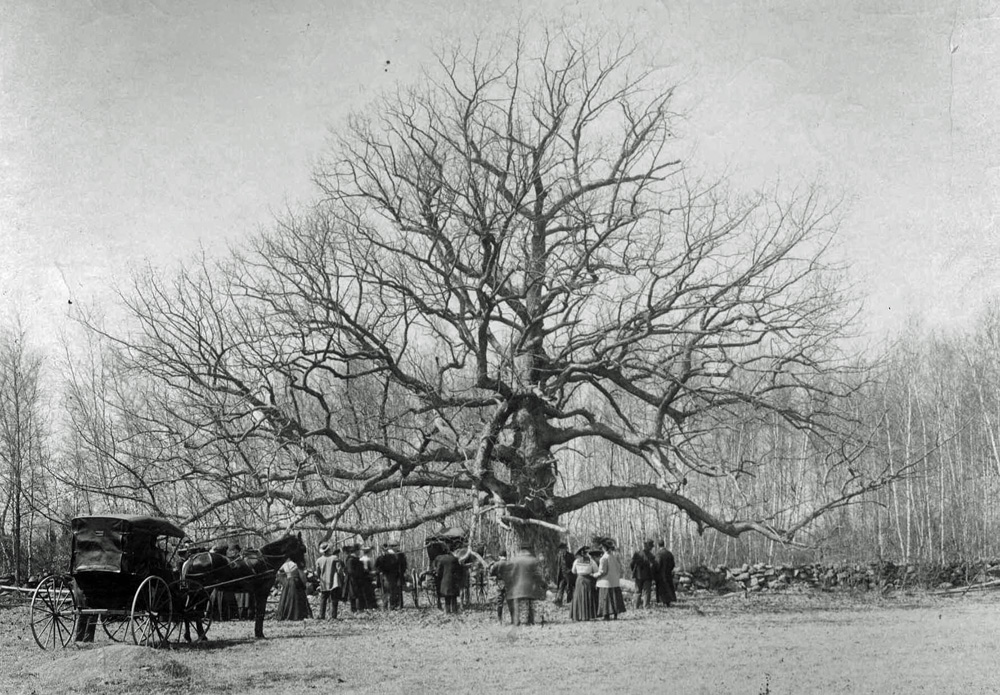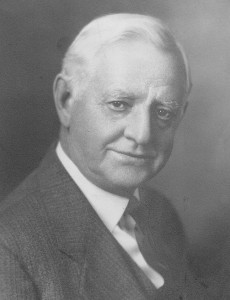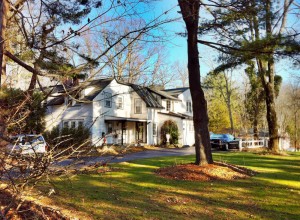True Tales from Canton’s Past: Nixon Waterman
By George T. Comeau
The Canton Historical Society visits “The Farms” near present-day York Street. (Courtesy of the Canton Historical Society)
The quintessential New England road is one that is overarched with gracious old trees and dotted with ancient stonewalls. There are a few notable candidates that spring to mind: Elm Street, Green Street, Chapman Street and certainly York Street. Of these, York Street is one of the oldest and most developed, and is considered a very desirable place to live. Property values are high and houses sell swiftly, yet this was not always the case.
In the late 1800s and into the next century there were a small handful of families that lived in what has locally been called “east” Canton. The part of Canton just over the Turnpike, Route 138, had been historically known as “The Farms,” owing to the large amount of fields and tillable land that remained largely undeveloped well into the mid 1900s.
One of Canton’s most famous inhabitants of this area was Nixon Waterman. It is safe to say that among this country’s most famous newsmen and poets, Waterman would be near the top of the list. Born in 1859 in Newark, Illinois, Waterman was the son of Lyman and Elizabeth Waterman. Lyman Waterman was an industrious individual who was in the truest sense a pioneer. Working as a laborer for $10 a month, he eventually saved enough money to buy a farm that straddled La Salle and Kendall County in Illinois. It would seem that the family was always moving, and after living in Sheffield and then Buda, Illinois, the family moved to the frontier of southwest Iowa.
Arriving on August 6, 1869, in what was formerly Indian Territory, the Watermans bought a 200-acre farm, 100 acres of which was “broken,” on section 26 of Douglas Township, Union County, and built a house. Lyman Waterman had become a cattle dealer, and young Nixon herded stock across the open prairie. By all accounts the Waterman ranch was a stopover for hundreds of prairie schooners that brought families to a new horizon in American history.
Imagine the stories that young Nixon Waterman heard during his life on the family ranch in Iowa. And it was these stories that formed the young man’s aspiration to become a newsman. At age 15, Waterman found work as a “printer’s devil” on a failing local newspaper. After teaching school for three winter seasons, Waterman joined the staff of the Creston Idaho Advertiser — the local weekly paper. Working his way up the ladder, he landed bigger and better jobs.
In 1889, Waterman began work at the Chicago Herald, and by 1895 he was in Boston as the editor of the immensely popular League of American Wheelmen Bulletin. The American Wheelmen Bulletin was an early magazine that supported the bicycle craze that was sweeping the nation. The circulation was quite large, and the league was responsible for early lobbying efforts on behalf of roadway improvements and civic support for bicyclists.
Waterman is best known, however, for his essays and verse and is one of the most quoted writers of the 20th century. Waterman’s prolific writing included 49 complete works in over 118 publications. Poems, stories, songs, anthems, and books allowed Waterman a standing that few others would achieve. The appeal of Waterman’s work was largely due to the fact that he was a keen observer of the seasons and “the vagaries of mankind.” Moving to Canton in 1919, Waterman and his wife, Nellie, purchased 48 acres of land for the sum of $3,800 along the rural York section.
In Canton, Waterman’s life was idyllic. His summer home at 316 York Street is still standing. As you drive up York Street and just before Spruce Lane and Waterman Road you will see Fair Acres; this was Waterman’s small estate house.
An enthusiastic gardener, his flowers were among Canton’s finest. On July 10, 1928, Waterman was issued patent number 1676468 — an invention he created here in Canton called the Han-D Plant Support. Basically, this item was a “simple, durable, compact, and efficient device formed entirely of wire,” which could be turned in the ground such that “growing plants are properly supported during various stages of their growth.” In two words, a garden stake. It is likely that this invention yielded far less income than Waterman’s writing efforts.
The quiet life in Canton was interrupted in 1926 when Waterman received his tax bill from the Board of Assessors. In 1925 he was taxed $76.85 for the land and improvements; the 1926 bill was for a whopping $255. Waterman planned his attack and rallied his neighbors. After a long bout with diphtheria, Waterman was unable to appear before the assessors in an effort to seek abatement for his annual taxes. A letter penned by one of America’s best-known authors issued forth. “I will be as brief as possible,” he wrote. “Nearly forty years of newspaper editing have taught me that more words than are necessary are usually employed.” The “five-page” letter was anything but brief and listed a litany of complaints against the valuation for 1926.
Among Waterman’s complaints about his York Street neighborhood, he observed, “We are still five miles from Canton … there should be no increase in valuations from the previous years since there has been no increase in inducements for people to make their homes in this section.” A new waterline had been laid in 1925, and the Board of Assessors raised the taxes in the York Street area by more than 70 percent over the previous year. Waterman listed all the inequities facing York Street residents, from extra phone mileage charges, to additional costs to bring coal to this section of town, and the coatings of dust from unoiled roads that ensured houses must be “kept closed during the dry season.”
Living on York Street at the dawn of the automobile age also had undesirable consequences. To live in the York section, “one must keep an auto. Over our rotten roads autos age fast and die young. A prudent prospective buyer would think twice before buying (with such roads) and then buy elsewhere.” Waterman continues, “With increasing hosts of automobiles not averse to helping themselves to roadside farm and garden crops, and petting parties who are fond of parking in the woods or meadows and inviting nature, frontage on a highway these time is not desirable and should be taxed far less for farm purposes than back lands.” Hmmm, “petting parties” leads one to wonder …
Eleven families, led by Waterman, marched on Memorial Hall and demanded answers in a public hearing before the county commissioners. The hearing was formal and polite, yet the spectacle made front-page headlines. The new tax levy amounted to three or more years’ worth of taxes to be paid in one year. To live in the York section must have been horrendous — lack of police and fire protection and impassable roads in winter, as well as lack of a trolley or bus service and the dangerous crossing at Turnpike Street were all reasons for abatement. The assessors, led by Joseph Galvin, were only slightly swayed, and Waterman persisted. “Many acres have never been seen and could not be seen without wearing rubber boots,” he protested.
The matter was brought before the Norfolk County Commissioners, where, even after two small abatements, the York Street residents failed to reverse their rates to the 1925 levels. It took 100 days for the county commissioners to render a verdict in favor of the assessors. In their decision the county commissioners blamed the residents themselves for the 70 percent tax increase: “The York Street residents are of the opinion that the increases were imposed to take care of a new water main … after a 15-year fight by the York section dwellers to obtain town water.”
Waterman’s taxing defeat did not seem to affect his future in Canton. Splitting time between Canton and his winter estate “The Acorn” in Orange Park, Florida, he lectured widely and continued to be widely published. Nixon and Nellie lived a long life together surrounded by friends. In 1940, Nellie Waterman died in Canton, and in November, at age 80, Waterman immediately married Grace Leavitt, a longtime “friend” who worked as a secretary for the state Department of Corporations and Taxes. The second marriage lasted four years until Waterman died on September 1, 1944. After a funeral in Canton, his ashes were buried in the family plot at Mt. Auburn Cemetery.
When you receive your quarterly tax bill, think about Nixon Waterman and what it takes to live on York Street in the modern age.
Short URL: https://www.thecantoncitizen.com/?p=10195












